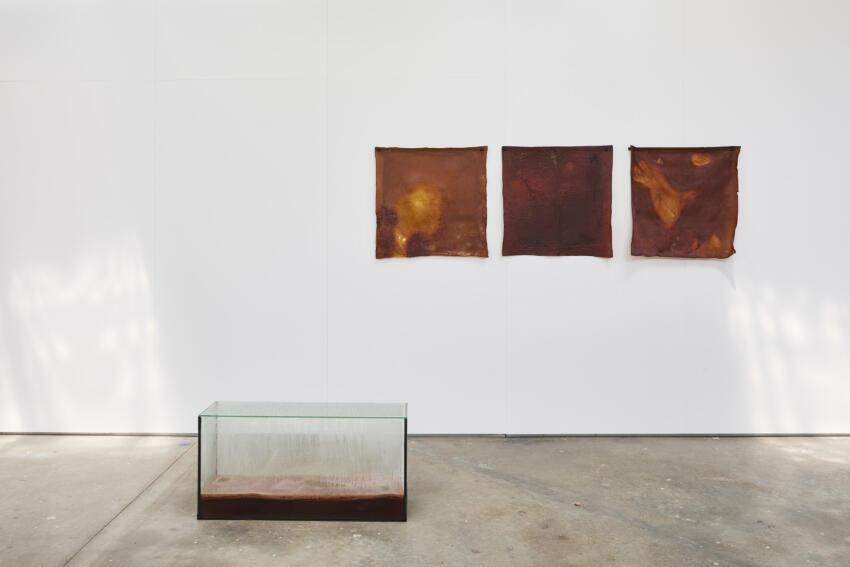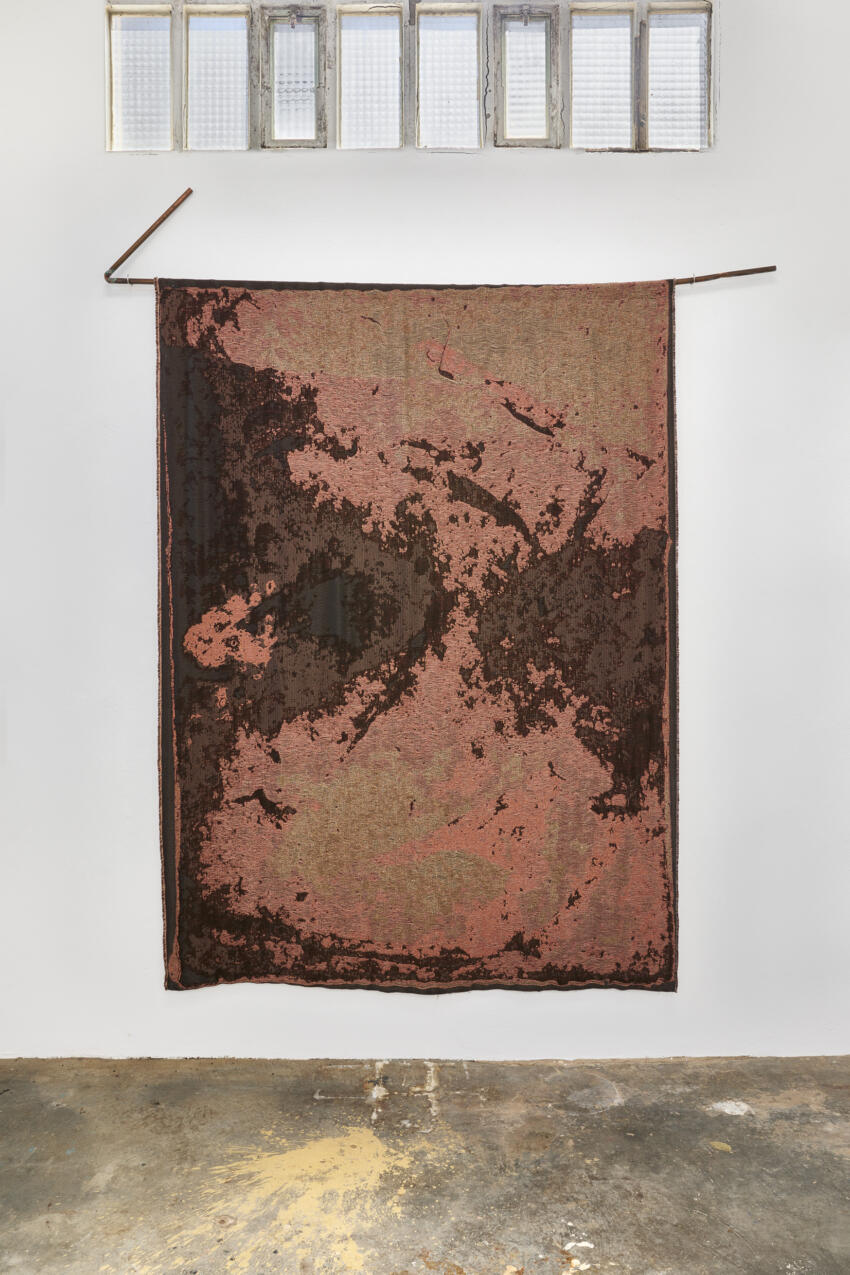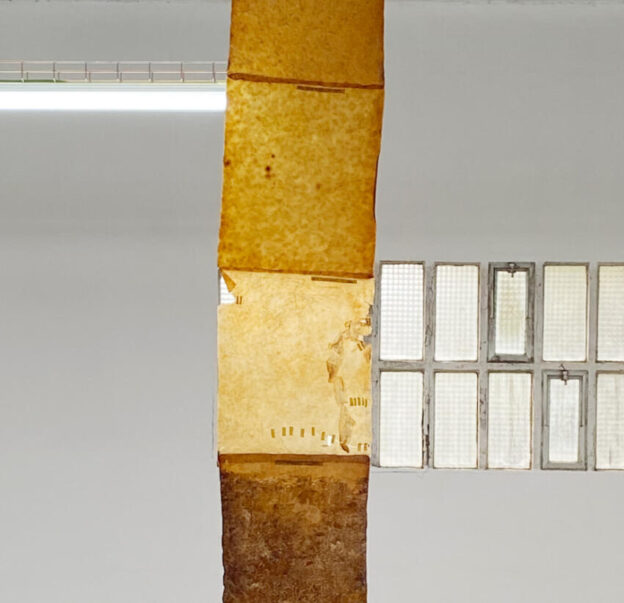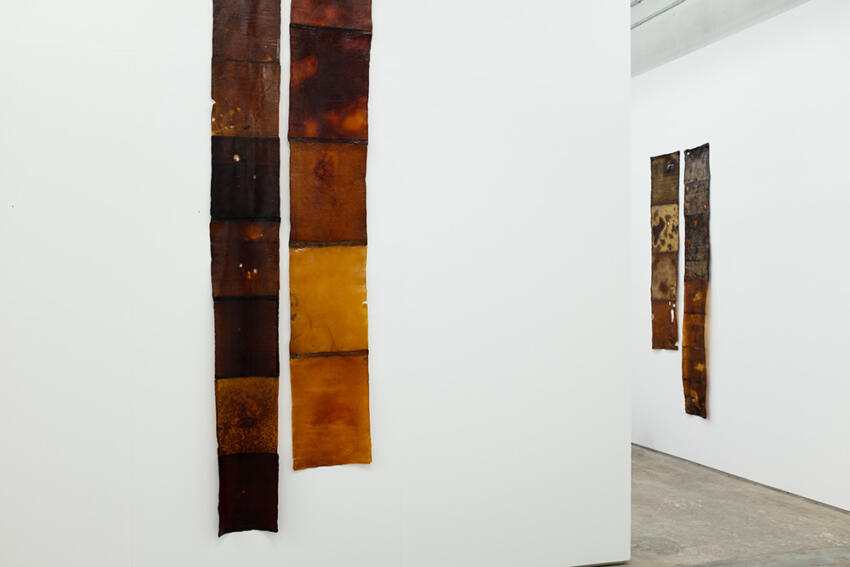Just as human skin carries the imprints of time, bacterial grown skins age and transform.
Within their folds, memories are preserved, silently narrating the stories of their existence. Memories reside not only in the folds of these Sensorial Skins but also in the smells they emit. A specific scent can transport us back to a particular moment, evoking a sense of nostalgia and temporal connection.
The Sensorial Skins embody a remarkable flexibility and softness, akin to organic textiles. They adapt to the ever-changing needs of their environment, exhibiting a responsiveness that defies rigidity. In their pliability, we find an invitation to engage in a dialogue with the material world, acknowledging the agency of these living fabrics and our own role as co-creators.

Acuario con Acetobacter xylinum (2023) – 99cm x 50cm x 30cm. Fermentation in process.
Triptique of Sensorial Skins (2023) – Earl Grey, Hibiscus, Gunpowder.
In a large aquarium, a fermentation process is taking place. The generative process is in a constant state of transition. This is the place where the Sensorial Skins are created. The bacterial woven fabric reacts to variable invisible factors as temperature, humidity and the local enzymes in the water and the air. Every newly grown Sensorial Skin is thus the unique result of the specific site were it is grown, with its own metabolism and aesthetic specificities.
Since 2015, Anne Marie Maes has been developing organic material by fermenting bacteria and yeasts that leave behind a brownish vegetable leather once they are removed from their substrate. Some skins are colored in the growth medium with natural dyes such as hibiscus and curcuma, while others are colored through capillation processes.
These biofilms, which expand, curl and harden with air temperature or humidity are called Sensorial Skins to emphasize their living and evolving nature. The skin acts simultaneously as a protective layer and as an interface between the external and internal environments. The microbiological world thus exposes itself to our gaze in the form of these rectangular skins displayed on walls or presented in light boxes where every line and detail of their matter is accentuated. The roughness of these membranes indicates their origin as the fruit of an agglomeration of different bacterial colonies. The resulting skins can then be read as topographic maps bearing the marks of their gradual aging.
Microbial Ancestors (Topography of a Sensorial Skin) -the pink tapestry- is a woven interpretation of a Sensorial Skin. Its topographic view visualizes the ecology of the symbiotic organism composed of Acetobacter xylinum bacteria and Saccharomyces cerevisiae yeast cells and the several layers of cellulose woven by these bacteria to create the skin. The original Sensorial Skin -which was model to the woven interpretation- was grown in a culture of fresh hibiscus tea, giving the pink color to the skin. When translated into a textile medium, it results in a play of light shining through the lightly woven, multi-layered work, reminiscent of the multiple layers woven by bacteria. The artwork is realized on a computer-controlled, state-of-the-art Dornier Jacquard weaving machine at the TextielLab in Tilburg (Nl), with an array of organic fibers: linen, paper, polyester, elirex and cotton.

Microbial Ancestors – Topography of a Second Skin, pink (2023) – 225cm x 166cm, organic fibers
Salt marshes are unique ecosystems at the transition of land and sea. They harbour plants and animals adapted to cope with salt stress. Intertidal salt marshes occur along the edges of shallow seas with soft sediment bottoms where the tidal range is considerable, zones that are flooded regularly by the tides. The obvious coloration of the salt marsh is caused by its microscopic algae, which produce the pigment beta-carotene. As the water temperature rises, and if the salt content is high, the water will redden as the algae reproduce.
Red clay covers a considerable part of the ocean floor and accumulates very slowly. It consists of sediment left over after the dissolution of both calcareous and siliceous particles. Most of the red clay is eolian dust, and additional constituents are meteorite dust, fish bones and teeth, whale ear bones and manganese micro-nodules. The bright red color of the clay is the result of coatings of iron oxide and manganese oxide on the sediment particles.

Salinas d’Addaia (2023) – 200cm x 100cm, hot rolled steel and red clay from the salinas of Menorca
Sensorial Skin, archaïc black (2017) – 200cm x 42cm
Second Nature, group show with
Nicolas Bourthoumieux, Martin Belou et Anne Marie Maes.
du 15.06.2023 au 12.08.2023
Galerie 10N Menorca
Av. d’es Castell, 3
07720 Es Castell, Illes Balears, Espańa
https://10n-menorca.com – Second-Nature
Open from Tuesday to Saturday
10:00 – 13:00

